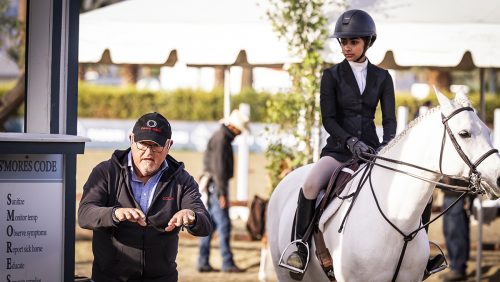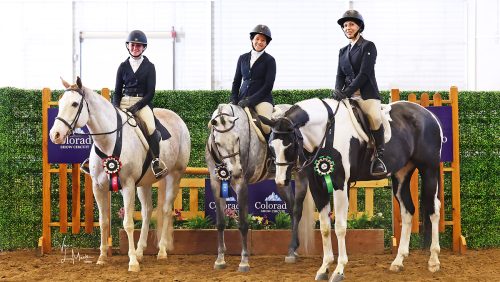The $100,000 USGPL Invitational Grand Prix provided the perfect Hollywood setup. Aboard the final horse left to go in the second round, last year’s winner took to the course.
Todd Minikus and Gardenio had just turned in the only clear jump-off round to that point. The Hanoverian gelding by Graf Grannus was fast, and few believed he could be caught. Vale, on the Australian Thoroughbred Boxster, proved the doubters wrong. The pair stopped the clock more than a full second faster than Minikus and Gardenio had, and Vale led the victory lap for the second consecutive year. The grand prix was the finale of the HITS VI USGPL Finals horse show, held Sept. 28-Oct. 3 in Culpeper, Va.
Asked where he thought he’d beaten Minikus, Vale laughed. “I think when we tacked our horses up,'” he said. “I’m riding a Thoroughbred, and he’s on a big, slow warmblood. I told Todd that ‘I didn’t outride you, I out-Thoroughbreded you.’ “
Vale followed essentially the same track as Minikus, but simply did it faster. “My horse is just quicker across the ground,” Vale said.
Vale got the ride on Stuart Tinney’s Boxster earlier this summer at the request of George Sanna, who had campaigned the horse in the United States throughout the spring. “George has a wife and kids and a business back in Australia,” Vale said. “He had to go home.”
Sanna asked Vale to ride and market the horse for him. The result so far has been three grand prix victories for the pair, including the USGPL’s $25,000 Wild Card Grand Prix on Friday.
His connections never intended for Boxster to be a grand prix horse, and he did not start that part of his career until the relatively late age of 9. Boxster began his competitive life in eventing, showing eventually at the three-star level. “In the cross-country and dressage, he couldn’t quite cut it for the Olympic level,” Vale said. “So they converted him to a show jumper. And it looks like he’s quite a good one.”
Course designer Olaf Petersen is always a little worried before a big class. “It is always for the course designer the same as for the rider. If you have the big grand prix in front of you, you are a bit nervous,” he said. “If you say, ‘It’s just another show,’ then you are not the right person.”
Petersen, from Germany, gets relatively few opportunities to work in the United States. He knew very little about the horses and riders for whom he’d be building in Culpeper, so he was glad that many of the same horses showed in Friday’s $25,000 class. “It gave me a very good idea of what I could expect for Sunday,” he said. But even before that class, Petersen knew he’d be building big. “I thought, for $100,000, they have to jump,” he said.
A Change Of Luck
Patty Stovel has always felt a little unlucky at the USGPL finals. The Culpeper, Va., trainer has finished second in the Stillwell-Hansen/Four Winds Farm Pre-Green Hunter Classic at least three times. She finally laid that curse to rest when she rode Jay Golding’s Milan to the win in the $10,000 invitational.
Stovel had to stay on her game through the very end. Sandy Ferrell came to the ring with the Oare’s hunter Late Entry and turned in a spectacular round to take the lead. “I saw Sandy go. She got an 85, and I thought, ‘Great. I’m going to be second again,’ ” Stovel said. Stovel and Milan were awarded an 86, however, and took the blue.
ADVERTISEMENT
Milan was relatively inexperienced when he came to the ring on Saturday afternoon. In fact, the Dutch-bred gelding was at his first U.S. horse show. “He’s been here three weeks,” Stovel said.
She showed him in two pre-green classes on Thursday, his first time ever in a hunter ring, and in two schooling hunter classes on Friday. That seemed to be all the 6-year-old needed by way of preparation. “He gives you such a good feeling at the jump because he’s so sincere,” Stovel said. “Every jump is like that. Every jump, he powers off the ground.”
Golding and Stovel plan to campaign Milan in the first year greens in 2005 and see where he goes from there. “I think he’s going to make a great junior/amateur horse because he’s so simple,” Stovel said.
Annie Frazier was happy to earn the championship with her South Boundary in the amateur-owner, 18-35, section, but she was even happier to have her horse back. After a long lay-up, South Boundary finally returned to the ring at Culpeper.
“We’ve worked him back slowly,” said the North Carolina amateur, who trains with Havens Schatt. “This is the first time I’ve shown him in two years.”
Frazier is a student at St. Johns College in Annapolis, Md., where she studies such abstruse subjects as mathematics, philosophy and ancient Greek. The school’s aim is to teach its students to use their brains. “It’s to make you think, so that when you go to graduate school, you can use your mind and really wrap it around what you want to study,” Frazier said.
The rigorous curriculum demands a great deal of Frazier’s time. There has to be room for horses, however. “I have to make time to ride,” she said. “It’s what I do and what I love.”
Pony Plans
Becky Gochman dominated the adult amateur, 36-40, section. The Houston, Texas, rider, who trains with Peter Pletcher, won all four classes over the jumps with her Primrose. She added all the red ribbons with her rides on Bohemia.
” feel really lucky to own both horses,”Gochman said. “rimrose goes into the ring every single time with a great attitude. She just goes around on a loose rein. She always keeps her ears forward, and she’ very happy to do her job.”
Gchman plans to breed both mares early next year. Bohemia will be bred to a pony stallion, in the hopes that the result will be a large pony for Gochman’ 22-month-old daughter. “It’s kind of oking into the future, but you never know,” she said.
Eizabeth Landes rode Ashmont Farm’s pony, Magic BB, to the win in the pony jumper classic. Landes, who trains with Allyson and Evan Coluccio, got the ride on the Dutch-bred jumper earlier this year. “He’s pretty much won every class he’s done,” said the Dayton, Va., junior.
ADVERTISEMENT
There is an extensive breeding program for pony jumpers in Europe, and Magic BB was one of the best. “He was seven-time international pony jumper champion with three or four different riders,” said Landes. “He’s an amazing pony. He can do equitation and hunters and jumpers–he can do everything.”
Landes, 15, has the usual teenage rider’s problem balancing horses and school. “I miss a lot for shows,” she said, a little ruefully. “I have a lot of work to make up.”
Robin Swinderman the office manager for Quiet Hill Farm in Florida, has only recently begun riding jumpers. But that didn’t keep her from winning the $15,000 Low Junior/Amateur-Owner Jumper Classic.
“It’s a lot more exciting,” she said, comparing jumpers to hunters. “After a while I get tired of going inside, outside, outside, inside.”
Swinderman, who trains at home with Christina Schlusemeyer and Bobby Braswell, won the class on Lord Byron Z, purchased last year from Angela Covert in Canada. Swinderman’s biggest problem making the transition to jumpers has been a tendency to go too slow. “I need to step it up and ride off the gallop,” said Swinderman.
She certainly did that at Culpeper, beating a field of 60 to earn the blue.
Lacy Morrone considers herself fortunate. The Cedars, Pa., amateur is mounted on a wonderful horse, Jewel’s Emerald II. “I was very lucky to get him from some very good riders,” she said. “He was in Europe, and Ben Schroeder was showing him as a second-string grand prix horse.”
Morrone booted the Holsteiner gelding home first in the $25,000 Junior/Amateur-Owner Jumper Classic. Morrone, who trains with George Morris and Chris Kappler, enjoyed riding Petersen’s course. “It was very technical,” she said. “When we walked it, it didn’t seem that bad. When we rode it, it rode pretty big.”
Like many of Petersen’s efforts, it was a rider’s course, requiring constant attention. “I would say there were a lot more choices to make,” Morrone said. “There were lines that were set on the half-stride, lines that were bending where we could choose either to leave the stride out, or add the stride in. He set a pretty challenging course.”
Morrone was particularly concerned about the triple combination. “It was a big vertical to a steady one-stride,” she said, “and then you had to ride pretty hard out over the last oxer in two strides.”














